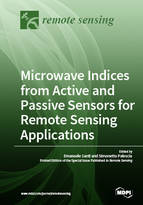Microwave Indices from Active and Passive Sensors for Remote Sensing Applications
A special issue of Remote Sensing (ISSN 2072-4292).
Deadline for manuscript submissions: closed (30 September 2018) | Viewed by 88410
Special Issue Editors
Interests: microwave remote sensing; soil moisture; vegetation biomass; snow water equivalent; SAR and microwave radiometers; GNSS-R, retrieval algorithms development; machine learning
Special Issues, Collections and Topics in MDPI journals
Interests: microwave remote sensing; soil moisture; vegetation biomass; snow water equivalent; SAR; microwave radiometry
Special Issues, Collections and Topics in MDPI journals
Special Issue Information
Dear Colleagues,
Past research well assessed the capabilities of satellite sensors operating at microwaves, both active (SAR, Scatterometers) and passive (Radiometers), for the remote sensing monitoring of Earth surface. Besides brightness temperature and backscattering coefficient, Microwave Indices (MI), defined as a combination of microwave data collected at different frequencies and polarizations, revealed a good sensitivity to several parameters related to the hydrological cycle such as the surface soil moisture (SMC), the Vegetation Water Content (VWC) and the Snow Depth (SD) and its Water Equivalent (SWE). The differences between microwave backscattering and emission at more frequencies and polarizations have been well related to these parameters, so that operational retrieval algorithms have been developed basing on the linear combination of active or passive microwave acquisitions.
This special issue aims at providing an overview of Microwave signal capabilities in estimating the main land parameters of the hydrological cycle, e.g. soil moisture, vegetation water content and snow water equivalent on both local and global scales, with a particular focus on the MI applications.
Dr. Emanuele Santi
Dr. Simonetta Paloscia
Guest Editors
Manuscript Submission Information
Manuscripts should be submitted online at www.mdpi.com by registering and logging in to this website. Once you are registered, click here to go to the submission form. Manuscripts can be submitted until the deadline. All submissions that pass pre-check are peer-reviewed. Accepted papers will be published continuously in the journal (as soon as accepted) and will be listed together on the special issue website. Research articles, review articles as well as short communications are invited. For planned papers, a title and short abstract (about 100 words) can be sent to the Editorial Office for announcement on this website.
Submitted manuscripts should not have been published previously, nor be under consideration for publication elsewhere (except conference proceedings papers). All manuscripts are thoroughly refereed through a single-blind peer-review process. A guide for authors and other relevant information for submission of manuscripts is available on the Instructions for Authors page. Remote Sensing is an international peer-reviewed open access semimonthly journal published by MDPI.
Please visit the Instructions for Authors page before submitting a manuscript. The Article Processing Charge (APC) for publication in this open access journal is 2700 CHF (Swiss Francs). Submitted papers should be well formatted and use good English. Authors may use MDPI's English editing service prior to publication or during author revisions.
Keywords
- Microwave Indices
- SAR
- Radiometers
- Scatterometers
- Hydrological Cycle
- Soil Moisture Content (SMC)
- Vegetation Water content (VWC)
- Snow Depth and Snow Water Equivalent







